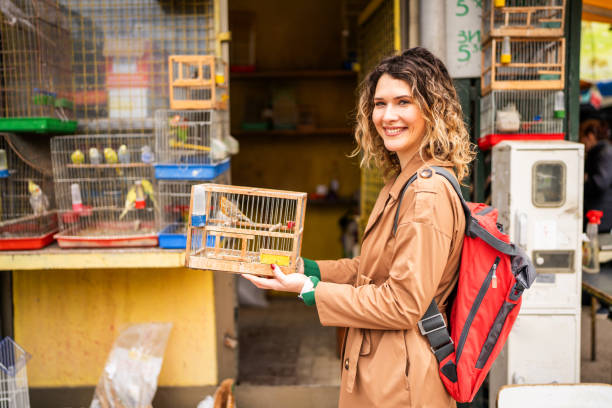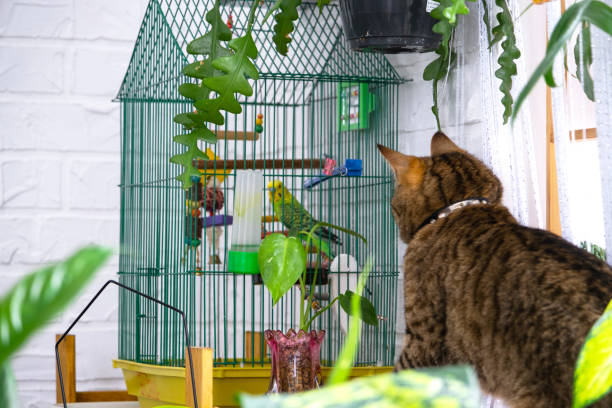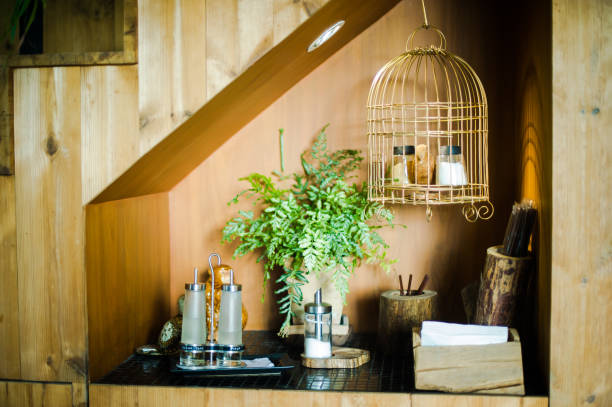 Spend AED 100 more for Free Shipping!
Spend AED 100 more for Free Shipping!
Common Bird Cage Mistakes and How to Fix Them

Common Bird Cage Mistakes and How to Fix Them
Your bird's cage is their whole world. Setting it up wrong can lead to stress, injuries, or even health problems. Here’s what you need to know to avoid common mistakes and keep your bird safe and happy:
Key Mistakes to Avoid:
- Wrong cage size or bar spacing: Too small or unsafe cages can harm your bird.
- Bad location: Direct sunlight, drafts, and noisy areas cause stress or health issues.
- Toxic materials: Avoid cages or toys made from zinc, lead, or unsafe metals.
- Lack of mental stimulation: Bored birds may pluck feathers or become aggressive.
- Poor cleaning habits: Dirty cages lead to infections, especially in humid climates.

Quick Solutions:
- Cage size: Choose a cage at least double your bird’s wingspan.
- Safe materials: Opt for stainless steel or non-toxic metals.
- Best location: Place the cage in a quiet, shaded spot with stable temperatures (24–27°C).
- Enrichment: Rotate toys every 10 days and include foraging or puzzle toys.
- Daily cleaning: Use non-toxic cleaners like vinegar and water.
By fixing these issues, you’ll create a safer, more comfortable environment for your bird. Read on for detailed tips and solutions.
What NOT To Put In Your Bird's Cage | Parrot Cage Setup | TheParrotTeacher

Mistake 1: Wrong Cage Size and Bar Spacing
Choosing the wrong cage size or bar spacing can put your bird's health and safety at risk.
The Problem with Cage Size: Too Small or Too Large
A cage that's too small limits your bird's ability to move, stretch, and exercise, leading to health problems like obesity and behavioural issues. Birds thrive when they have enough space to spread their wings and stay active. In fact, avian specialists highlight that insufficient cage size is a major factor contributing to obesity in pet birds [5] .
"If your mind concocts a scenario that has a bad outcome, pay attention! Birds get into everything… especially when you aren't watching!"
– Patty Jourgensen, Avian Health, Behavior and Nutrition Specialist [4]

As a general rule, the cage width should be at least 1.5 times your bird's wingspan. However, for optimal comfort and safety, double the wingspan is recommended. This ensures your bird has enough room to move freely, reducing the risk of injury and stress-related behaviours [5] .
Cage Size and Bar Spacing for Common Birds
Different bird species have specific requirements when it comes to cage dimensions and bar spacing. Here’s a quick guide to help you make the right choice:
| Bird Type | Minimum Cage Size (L x W x H) | Bar Spacing |
| Budgies | 99 x 51 x 81 cm | 12.7 mm |
| Cockatiels | 61 x 46 x 61 cm | 12.7–15.8 mm |
| African Greys | 61 x 91 x 122 cm | 19–25.4 mm |
| Conures | 61 x 61 x 76 cm | 15.8–19 mm |
Improper bar spacing can also pose a serious hazard. For example, a cockatiel tragically lost its life after its head became trapped between bars that were too far apart. As one expert explains:
"Heads are strange things. They fit into certain places, but they don't always want to come back out again. The hinge of the jaw (and the ears on humans) act as a barrier and the head can get locked into place." [4]

Key Factors to Consider When Choosing a Cage
When selecting a cage, keep these points in mind:
- Height matters: Birds with long tails, like cockatiels, need taller cages to prevent tail damage [3] .
- Bar spacing safety: If you're unsure, always go for smaller bar spacing to avoid accidents [5] .
- Room for movement: Ensure the cage allows for natural activities like wing-stretching, climbing, and playing [3] .
Getting the dimensions right is just the first step. Next, think about where to place the cage to create a safer and more comfortable environment for your bird.
Mistake 2: Bad Cage Location
Placing a bird's cage in the wrong spot can lead to stress and serious health problems, especially in the UAE's extreme climate.

Location Risks: Sun, Draft, and Noise
Small birds can suffer heatstroke in as little as 15 minutes when exposed to direct sunlight [7] . Unlike wild birds, caged birds can’t escape such conditions, making their placement a matter of life and death [6] .
Here are common placement risks and their potential effects:
| Risk Factor | Potential Consequences |
| Direct Sunlight | Heatstroke, dehydration, death |
| Kitchen Fumes | Respiratory issues, toxicity |
| Localised AC Drafts | Illness, temperature shock |
| High-Traffic Areas | Sleep disruption, anxiety |
| Window/Door Drafts | Respiratory problems, stress |
"If it is too hot for YOU to be outside, bring your birds inside." – Patty Jourgensen, Avian Health, Behavior and Nutrition Specialist [6]
Best Spots for Bird Cages
Pet birds generally thrive in temperatures between 24–27°C [9] . In UAE homes, you can maintain this by carefully choosing the cage's location:
- Place the cage against a solid wall, away from direct sunlight.
- Choose a room with stable temperatures, avoiding sharp fluctuations.
- Keep the cage away from air conditioning vents or direct drafts.
- Position it where the bird can observe family activities but still have a quiet retreat.
Experts suggest creating a "safety zone" within the cage - a wall-facing section where the bird can feel secure. This is particularly important for prey animals like parrots [8] .

Watch for signs of stress or heat-related problems, such as:
- Drooping wings and open-beak breathing
- Excessive screaming or an unusual lack of noise [10]
- Stress lines on feathers [10]
- Aggression or loss of appetite [10]
If you notice symptoms of heat distress - like drooping wings or laboured breathing - relocate the cage immediately. Use a fan to cool the room, but avoid directing airflow at the cage. Keep the room temperature stable, as fluctuations of more than 11°C can be harmful [6] [7] . Cover the cage during sleeping hours to ensure 10–12 hours of darkness and shield your bird from early morning sunlight [9] .
Mistake 3: Dangerous Materials and Parts
The materials used in bird cages and accessories can have a huge impact on your bird's health. Some common materials may seem harmless but can actually lead to severe health issues - or worse - if they contain toxic substances that your bird might chew on or ingest.

Materials to Avoid
Certain materials can pose serious risks to your bird’s well-being. For instance, blood zinc levels above 2 ppm are a clear sign of zinc toxicosis, a condition that can severely damage organs [11] . Here are some materials to steer clear of:
| Material | Common Sources | Health Risks |
| Galvanized Metal | Cheap cages, wire mesh | Zinc poisoning, liver damage |
| Brass | Bells, decorative items | Heavy metal toxicity |
| Copper | Old fixtures, wiring | Heavy metal poisoning |
| Lead | Chipped paint, old toys | Nervous system damage |
| PTFE Coating | Non-stick surfaces | Respiratory and cardiac issues when overheated |
Signs of Metal Poisoning:
If your bird has been exposed to toxic materials, watch for symptoms like:
- Excessive urination or thirst
- Unexplained weight loss
- Weakness or lethargy
- Gastrointestinal problems
- Seizures or unusual behaviour
Safer Alternatives
Providing a safe environment starts with using non-toxic materials. Here are some reliable options:
Recommended Materials:
- Stainless Steel: This is considered the gold standard for bird cages and accessories. It's rust-resistant, durable, and free from harmful coatings or paints.
- Aluminum: Forms a non-toxic oxide layer when it corrodes, making it a safe choice.
- Nickel-Plated Metal: Safe as long as the plating remains intact.
- Wrought Iron: A strong, non-toxic alternative for cages and other fixtures.
"Stainless steel is widely regarded as one of the safest materials for bird cages, toys, and accessories. It's durable, rust-resistant, and does not contain harmful coatings or paints." - Poodles and Parrots [12]
Safety Maintenance Tips:
- Regularly clean metal toys and chains with diluted vinegar to remove any buildup.
- Replace items that show signs of wear, chipping, or corrosion.
- Inspect your bird’s cage monthly for any signs of material deterioration.
- When in doubt about a material’s safety, opt for stainless steel - it’s a safer bet.
For galvanized cages, scrubbing with vinegar can help remove zinc oxide buildup, but replacing the cage altogether is the best long-term solution. Up next, we’ll discuss how regular maintenance can further ensure your bird’s safety.
sbb-itb-8db4b3d
Mistake 4: Lack of Mental Stimulation
Once you've sorted out space, location, and safety, it's time to focus on another crucial aspect of your bird's well-being: mental stimulation.
Birds are naturally curious and intelligent creatures. In the wild, parrots can spend up to 18 hours a day foraging for food, keeping their minds and bodies active. Compare that to pet birds, which might only spend about an hour on similar activities - it's clear that they need more ways to stay mentally engaged [15] .
Striking the Right Balance with Toys
Toys play a huge role in keeping your bird entertained, but balance is key. Overloading the cage with too many toys can make it feel cramped and stressful, while too few can lead to boredom. And boredom in birds often shows up as feather plucking, excessive screaming, aggression, or sudden changes in behaviour [15] .
Choosing and Rotating Toys
The type of toys you provide - and how often you switch them out - can make a big difference. For example, interactive options like the JW Peck-A-Mole Bird Toy are great for encouraging natural foraging behaviours. It’s a safe choice made from non-toxic materials and is readily available in the UAE. Another excellent option is the JW Pet Hol-ee Roller, which promotes physical activity while keeping safety in mind.
Types of Toys Your Bird Needs:
- Foraging toys: These let you hide treats, encouraging your bird to work for its food, just like in the wild.
- Puzzle toys: Perfect for challenging your bird’s problem-solving skills.
- Chewable items: Birds love to peck and shred, so these satisfy their natural instincts.
- Physical activity toys: Encourage movement and active play to keep them fit.
"Birds can become bored with nothing but the same toys, and rotating to new toys 2-3 times per month can give the bird exciting new games to play." - Kaytee.com [14]
How to Rotate Toys Effectively
Keeping your bird's environment fresh doesn’t have to be complicated. Here’s a simple strategy:
- Weekly Check: Inspect toys every week and replace any that are worn or unsafe.
- Rotation Schedule: Prepare several sets of toys and rotate them every 10 days or so. This keeps things interesting.
- Smart Placement: Place interactive or food-related toys near feeding areas, while quieter toys can go near resting spots.
Don’t forget to pair toy rotation with daily interactive play outside the cage. This is especially important for popular pet birds in the UAE, such as budgies, cockatiels, and African greys. Regular playtime helps prevent the "cabin fever" effect, which many caged birds can experience [10] [13] .
Mistake 5: Poor Cleaning Habits
Keeping your bird's cage clean isn't just about appearances - it's crucial for their health. In the UAE's humid climate, bacteria and fungi can thrive quickly, leading to serious health issues for your feathered friend.
Common Cleaning Mistakes
Some cleaning products that seem effective for humans can be harmful to birds, particularly because of their sensitive respiratory systems. Here's a quick guide to what to avoid and safer alternatives:
| Cleaning Product | Why It's Harmful | Safe Alternative |
| Bleach | Toxic fumes, harmful residue | White vinegar solution |
| Ammonia-based cleaners | Causes respiratory damage | Hydrogen peroxide (3%) |
| Air fresheners | Contains chemical irritants | Natural ventilation |
| Pine-scented products | Toxic phenols | Grapefruit seed extract |
In addition, steer clear of porous materials like wood, wicker, or bamboo for cage furnishings. These materials can trap bacteria and are difficult to sanitise, especially in humid environments [16] .
Daily and Weekly Cleaning Steps
Establishing a regular cleaning routine can significantly reduce the risk of infections and keep your bird healthy.
Daily Tasks:
- Remove waste and clean food and water dishes with hot, soapy water.
- Wipe down the cage bars.
- Sweep the area around the cage to remove fallen debris.
Weekly Tasks:
- Clean the cage grate and perches thoroughly.
- Sanitize and rotate toys to keep them safe and engaging.
- Replace the cage liner with a fresh one.
For a deeper clean, consider a monthly routine using one of these natural solutions:
- A mix of 1 part white vinegar to 2 parts water.
- 10–15 drops of grapefruit seed extract per cup of water [18] .
Tips for UAE Bird Owners
Humidity in the UAE can be a challenge, so here are some extra steps to ensure your bird's environment stays healthy:
- Clean water bowls twice a day to prevent bacteria buildup.
- Use air conditioning to manage humidity levels.
- Install an air filter to minimise dander and airborne particles.
- Provide regular baths for your bird to reduce dust and keep their feathers clean.
Always check for mould or mildew, especially in corners or hidden spots in the cage. When doing a deep clean, ensure the cage is completely dry and well-ventilated before allowing your bird back in.
Conclusion: Building a Better Bird Home

When choosing a bird cage, always prioritise one that is at least twice your bird's wingspan in both height and width. This supports their natural movement and promotes better overall health [2] . Additionally, place the cage in a location that avoids direct sunlight and harmful fumes [17] .
By addressing common mistakes - like selecting the wrong cage size, placing the cage in an unsuitable spot, using hazardous materials, or neglecting proper cleaning - you can create a healthier and happier environment for your bird. Here's a quick reference guide to help you cover all the key aspects:
| Aspect | Essential Requirements | Why It Matters |
| Size | At least 2x the bird's wingspan | Allows natural movement and exercise |
| Materials | Stainless steel | Avoids toxic exposure and ensures durability |
| Location | Central, away from the kitchen | Combines social interaction with safety |
| Enrichment | A mix of perches and toys | Keeps your bird engaged and active |
| Maintenance | Daily and weekly cleaning | Prevents infections and maintains hygiene |
For those living in the UAE, it's especially important to consider the local climate. Proper ventilation and humidity control are essential to ensure your bird's comfort. Strategic cage placement can help maintain good air circulation while avoiding extreme temperatures.
Whether you're a first-time bird owner or have years of experience, investing in the right cage, materials, and enrichment tools is key to supporting your bird's well-being. A well-thought-out setup provides the perfect balance of space, safety, and stimulation, creating a home where your bird can truly thrive.
FAQs
What is the right cage size and bar spacing for my bird species?
Choosing the Right Cage Size and Bar Spacing
Selecting the correct cage size and bar spacing is crucial for your bird's well-being. Your bird's cage should be spacious enough to allow it to stretch its wings fully, turn around with ease, and move freely without its tail feathers brushing against the sides or bottom. When it comes to cages, bigger is better, provided the bar spacing is appropriate for your bird's size.
Bar spacing plays a vital role in keeping your bird safe. For smaller birds like finches or canaries, the ideal spacing is 6 to 12 millimetres. Medium-sized parrots, such as cockatiels, do best with 12 to 20 millimetres of spacing. Larger birds, including macaws, need bar spacing between 25 to 40 millimetres to prevent injuries and ensure they can't get their heads stuck.
Take into account the unique requirements of your bird's species and, if unsure, seek advice from a reliable guide or an expert. Choosing the right cage ensures your bird remains comfortable, safe, and content in its home.
How can I tell if my bird is stressed because of its cage location, and what can I do to improve it?
Birds can exhibit stress through behaviours such as excessive biting, unusual vocalisation (either too frequent or too quiet), feather plucking, loss of appetite, or repetitive movements. If you spot these signs, the location of their cage might be causing them discomfort.
To ease their stress, try relocating the cage to a peaceful and quiet spot in your home, away from loud noises, direct sunlight, or areas with constant activity. Avoid placing it near windows where sudden outdoor movements or disturbances could startle them. If you've recently moved the cage, consider putting it back in its original position - birds often find comfort in familiar surroundings. Also, make sure their environment is inviting and stimulating by including toys, perches, and maintaining a comfortable temperature. A cosy and enriched space can help your bird feel more secure and content.
How can I keep my bird entertained by rotating its toys effectively?
To keep your bird happy and mentally sharp, switching up their toys regularly is a must. Doing so prevents boredom, supports natural play instincts, and encourages curiosity. Birds tend to lose interest if they see the same toys day in and day out, so swapping them out often keeps things fresh and engaging.
A good approach is to have 2–3 sets of toys with different textures, shapes, and purposes. Rotate these sets every week or even every few days, depending on your bird’s preferences. Watch how your bird reacts - some may crave new toys more often. This habit not only keeps your feathered friend entertained but also helps the toys last longer while keeping your bird lively and content.




 Facebook
Facebook